
30 minute read
“Where am I?” A Critical Discourse Analysis of Religious Representation
“Where am I?” A Critical Discourse Analysis of Religious Representation in Indonesia
Maretha Dellarosa The Ohio State University, USA
Abstract
The Indonesian Ministry of Education has re-examined the Indonesian curriculum to address the present challenges, including how to promote tolerance in students who live in a multicultural country. Textbooks and characters presented in Indonesian elementary textbooks, Buku Siswa, are part of continuous revision. However, there is insufficient consideration placed in the characters presented, including which characters are included and excluded. In fact, understanding which characters are presented means that people learn how to construct phenomenon. As a country with diverse beliefs, the Indonesian education system inserts religion as a mandatory subject, aiming to promote the values of diversity. Nevertheless, the goal of such implementation does not always meet the outcomes since there are conflicts that occur due to religious beliefs. The study aims to examine power relationships and the ideological nature of discourse that is represented by seven characters in Buku Siswa by utilizing Critical Discourse Analysis. Buku Siswa is a series of elementary school textbooks that has different levels and themes. Findings reveal that characters that represent minority religious groups are missing from learning materials, which presents them unequally compared to characters that presents the majority of religious groups. The study argues that representation is a way of respecting people.
Keywords: Critical Discourse Analysis, Indonesian Elementary Textbooks; Religious Representation
Even though Indonesian curriculum has continuously been revised to meet the current needs (Wahyuni, 2015), there is limited attention paid to the relevance of characters presented in Indonesian elementary textbooks taught across school age levels. The majority of elementary textbooks provide imaginary characters. For instance, there was only one group of children presented in textbooks published in the 1990’s (Alim, 1996) without any significant connection to the students’ identity such as religious or personal identity. Textbook producers’ goals for elementary students’ learning largely consists of questions geared toward reading for rote memorization (Apple, 2004). Students were rarely given an opportunity to position themselves within an “as if” storyworld and start interpreting “as if” characters’ lives in connection between themselves and others’ everyday lives (Enciso and Davilla, n.d). To put it another way, students are not challenged to analyze the characters presented in textbooks. In fact, reading is a matter of studying the real world in which students are living inside of, as the history has been perpetuated (Freire, 1985).
Moreno-Fernández et al. (2019) emphasize, “The significance of textbooks’ representation of the society as, in most cases, they lay the foundations for the way lessons are developed and are the guiding materials for the daily routines in the classroom” (p. 81). Representation is a way to formulate a phenomenon presented by establishing a relation between two objects through symbolic communication (Mitchell, 1990). It also means that people’s presence is acknowledged (Bartz & Bartz, 2018). The present study focuses upon representation of religion in Indonesian elementary student textbooks. In particular, the study illuminates religious representation of characters, through examining the ideological treatment of their identity, as diverse human beings who live on Earth. I argue that any form of representation is a matter of respecting people, regardless of their identity, as human beings who live on Earth because people will feel more accepted when their religion is presented in textbooks.
In the published 2013 curriculum, the publishers and the Indonesian Ministry of Education considered presenting diverse characters in Indonesian elementary textbooks, Buku Siswa. In the Buku Siswa there are seven main characters with various skin tones and hairstyles. Some of them have light skin color and one character has dark skin color. Additionally, the publishers and the Indonesian Ministry of Education emphasize religious representation among the seven characters. One of the characters, named Siti, wears a hijab as part of her religious enactment as a Muslim. In Indonesia, Muslim is the largest religious population (Ministry of Religious Affairs Public Relations, Data and Information Bureau, 2017). People who are part of a major religious group gain more social power (Van Djik, 1993) than people from a minor religious group.
Those with power control the hegemonic ideas and worldviews of a society (van Dijk, 1993). As such it is imperative to critically examine the Indonesian Ministry of Education’s representation of religion for reproduction of ideological dominance. This raises two questions: 1) What knowledge about religious representations are constructed in Buku Siswa? 2) Whose perspectives are valued in the process of scaffolding knowledge presented in Buku Siswa? As such this study analyzes a series of Buku Siswa taught in second grade level.
The (Religious) Diversity of Indonesia: Social Context
Indonesia is a multicultural country with 1331 ethnic categories, 719 local languages, six religions, and other beliefs. The six religions are Islam (87.2%), Protestant/Christian (7,0%), Catholic (2.9%), Hindu (1.7%), Buddhism (0.7%), Confucian (0.05%), and others (0.5%) (Badan Pusat Statistik, 2015, data reflective of 1991 to 2017). Others belief systems are defined
as aliran Kebatinan that are not recognized by any official religions. Aliran Kebatinan is defined as "mysticism, the penetration and the knowledge of the universe with the purpose of establishing a direct relationship between the individual and the sphere of That-Which-IsAlmighty" (Mulder, 1970, p. 105). The percentage of combined belief systems and religions was updated in 2010 following a census that is conducted every 10 years.
In an educational context, presenting religion as a subject was contested. Suhadi et al. (2015) explained that soon after independence, in 1945, the Indonesian government established the Ministry of Education, Instruction and Culture to bring "religious instruction" (the term used at the time) to the government’s attention. They described one of the articles in the first Indonesian Education Law as stating that religious instruction was a choice and not yet a mandatory subject in the era of "guided democracy" (Demokrasi Terpimpin) which lasted from 1959 to 1965. Nevertheless, religion was a mandatory subject (from elementary to university level for the first time) in the rise of Suharto’s era, also called the New Order era in 1965. Since presenting religious education was a new policy, there was criticism that introducing religion to children should be parents’ responsibility (Suhadi et al., 2015). Suhadi et al. added that the debate of presenting religion emerged from 1973 when religious education was proposed to be an optional subject again at the People’s Consultative Assembly (Majelis Permusyawaratan Rakyat) until early 2000s. However, religious education remains a mandatory subject in public schools even today and people rarely hear any criticism to eliminate it in public schools.
Even though debates of inserting religion as a subject in public school have ended, the implementation of religious education that aims to promote reflection and internalization of diverse values (Suhadi et al., 2015) seems far away in the Indonesian pluralistic society. Suhadi et al. argue that although religion became a mandatory subject, the implementation on how to value differences is weak because the curriculum consists of too much content about doctrine and there is lack of reflection on valuing diversity. There has been numerous religious conflict (Nurhidayah et al., 2018) across the nation in which dominant religious groups use their power to oppress minority religious groups.
For instance, there was a Christian – Muslim conflict in the 1950s, in which several churches were burned in Singkil, Aceh, Indonesia (Jones, 1976). In 2012, the same conflict happened in the same province, Aceh (Ahnaf et al., 2015). The majority of people in Aceh claim themselves as Muslim. The percentage of Muslims (98%) is bigger compared to Christians (1%) (Ministry of Religious Affairs Public Relations, Data and Information Bureau, 2017). Moreover, Aceh is the only province in Indonesia that enforces Syariat Islam (Islamic law). The conflict about religion in Aceh happened because some radical groups in Aceh believed that Christians obtained illegal permission to build a church. As a consequence, some conservative and radical groups viewed all activities done by Christians as illegal activities. Moreover, any type of activities done by the Christians could be a source of conflict for radical groups, such as Front Pembela Islam (FPI). Too often, this sensitive issue was used to justify discriminative action.
Another religious conflict occurred in Tolikara, Papua, Indonesia. Unlike Aceh, Papua is one of provinces in Indonesia with the largest population of Christians. The percentage of Christians (65%) is larger compared to Muslims (15%) (Ministry of Religious Affairs Public Relations, Data and Information Bureau, 2017). The conflict occurred on July 17, 2015 when Christians attacked Muslims, who were in Eid prayers, and burnt the mosque as the follow up action (Nurhidayah et al., 2018). The reason that the Christians gave for buring the mosque was because on July 13–19, 2015 they had wanted to organize an international seminar. The Christians argued that they did not want any other religious celebration on that day. Even
though these examples cannot be used to generalize religious problems in Indonesia, what happened in Aceh and Papua exemplify that dominant religious groups have more power than minor religious groups and the dominance perpetuates social inequality. Arguably, religious knowledge presented in schools fails to emphasize the value of diversity.
As such, there is a need to critically examine the knowledge depicted in textbooks and school curricula. We need to examine what and whose knowledge has been normalized (Foucault, 1980) and less valued by social institutions. As Sensoy (2014) argues, “our capacity to simply imagine the range of mundane life experiences of various groups is in part determined by the scripts and characters that we have been most socialized, through repetition, to see as normal” (p. 303).
Literature Review
There have been a number of studies about Indonesian textbook analysis across grade levels. The study of Fitriyani (2013) investigates how the Indonesian English textbook used for seventh grade is relevant to achieve the goals of the present curriculum. Fitriyani conducts a textbook analysis and thematic coding. One of the findings reveals that there is repetition of the content of the textbook. Additionally, Parlindungan et al. (2018) examined Indonesian cultural diversity and whose cultures are represented in middle school English textbook titled “When English Rings a Bell”. Using a semiotic approach to analyze textual and non-textual representations of cultures, the study’s finding revealed that the 2013 English textbooks for grades seven and eight permeated Indonesian cultural diversity. Moreover, the authors suggest the importance of inclusive representation of the richness of Indonesian local culture in a more salient manner, especially to the minority groups.
In elementary levels, first through sixth grade, two studies were found analyzing the Indonesian elementary textbooks for second graders according to the thematic approach. Kusumawardani’s study (2017) aims to describe the interconnection of the textbook in the second semester. The findings of this study demonstrate that the textbook for second graders has been combined among three or four subjects. Additionally, there were dominant interconnected models such as model webbed, threaded, and integrated in which several indicators are not fulfilled. Likewise, using quantitative methodology, the study of Jannah (2015) investigated the Indonesian elementary textbook for second graders (theme one, sub theme Hidup Rukun di Rumah) to examine four points:
• to what extent the indicators of materials are relevant to the learning activities • to know the relevance between learning activities and integrated approach • to know the relevancy between learning activities and scientific approach • to know the relevancy between the assessment in textbook and assessment in 2013 curriculum.
Research has found that there is a need to analyze the representation of characters presented in Indonesian elementary textbooks for second grade. Though the analysis of the study conducted by Parlindungan et al (2018) is about textual and non-textual representations of Indonesian cultures in middle school’s textbook, this study does not analyze to what extent the portion of majority or minority groups are presented in English textbooks. Thus, my research aims to contribute to the body of literature through the examination of the characters presented in second grade textbooks by using critical discourse analysis perspective.
Theoretical Framing
This study draws upon Critical Discourse Analysis (CDA) as a theoretical framework. CDA focuses on the reproduction of social power and dominance (van Dijk, 1993). Chu (2015) argues that dominant groups who have more access to the public domains gain more control to apply and validate their discourse in social institutions, including schools. The dominant groups within society are able to maintain power because other groups have limitations to acquire and use resources such as language, knowledge, and money for social mobility (Yosso, 2005). The dominant discourse then becomes a common rule when there is no significant link to a specific group from which it originates (Fairclough, 1989).
Van Djik (1993) explains the theory of power and dominance that can be measured by their control over (access to) discourse. “Control over certain discourses can lead to the acquisition of social goods (money, power, status) in a society” (Gee, 1989, p. 19). When a religion is positioned as dominant, it automatically has social power (Van Djik). Van Djik argues, “Social power is based on privileged access to socially valued resources, such as wealth, income, position, status, force, group membership, education or knowledge (p. 254). In the present study, an example of gaining access to socially valued resources (education) is the opportunity for several religions not only to be presented but also portrayed as main characters in textbooks.
By analyzing textbooks from the critical perspective, teachers and students are expected to examine how knowledge is constructed through the characters that are presented in textbooks. Having such understanding guides them to understand how power operates in society. As Enciso and Davilla (n.d) argue, “Understanding social equality means delving into the histories and frameworks that help us understand how ordinary people have exercised power and agency to produce social change and equality (p. 3)”. Furthermore, students are engaged in the process of doing critical analysis that guides them to understand how they perceive social issues from multiple perspectives (Chu, 2018). My role as a critical discourse analyst specifically in this study and more generally in society is to make a significant contribution in order to obtain more insight into the essential role of discourse in the reproduction of dominance and inequality (van Dijk, 1993).
Elementary Textbooks in Indonesia
The main books taught in elementary level are Buku Guru and Buku Siswa. These books are written and composed by authors, working together with a specific team under the coordination of the Ministry of Education. Buku Guru is a guided book for teachers that consist of several explanations on how to teach materials through a topic covered in each semester. Also, there are indicators of success for each subject. Similarly, Buku Siswa contains guidance, short imagined series of stories, and activities for students to engage in the learning process. The stories are the authors’ imaginations that may not all students would have experienced in their own lives. Furthermore, “Buku Siswa is designed to stimulate students’ imagination and interest by having full of pictures and colors” (Buku Siswa, 2017, p. iv).
This study analysis a series of eight textbooks (second edition, published in 2017), taught for second graders. These textbooks are connected in terms of characters and themes. To make it clear, there are seven characters presented in second grade’s textbooks (Picture 1). The students’ characters are named Meli, Udin, Beni, Dayu, Lani, Siti, and Edo. Besides characters, the textbooks are also connected in terms of themes. Each textbook’s themes are: Live in Harmony, Play in My Community, My Daily Duties, Live in A Clean and Healthy
Environment, My Experience, Take Care of Animals and Plants, Togetherness, and Safety at Home and During Travel.
Methodology
To examine what knowledge about religious representations are constructed in Buku Siswa and whose perspectives are valued in the process of scaffolding knowledge presented in Buku Siswa, I use case study research to iteratively construct and analyze data. This method allows me to investigate data carefully. I bound my case with religious representation as main analysis and the seven characters presented in textbooks as substance of analysis (Thomas, 2015).
I downloaded the eight textbooks from the Buku Sekolah Digital’s (BSD) website. BSD is an online application to download the e-books for free. This online application is an official program provided by the Departemen Pendidikan Nasional Indonesia (Indonesian Department of National Education), which aims to fulfill the need of digital books from elementary to high school level (Koleksi 2500 Buku Sekolah Digital (Buku BSE), Koleksi Buku KTSP 2006, Kurikulum 2013 dan Kurikulum Nasional, n.d.). BSD provides 2500 digital books including financial books, elementary textbooks, anti-corruption comics, educational comics, and many more. For the purpose of this study my focus of analysis is the digital textbooks.
I selected textbooks for second graders as a specific case because it was part of the early elementary levels (from first, seven years old, to third grade, nine years old). Furthermore, textbooks for second graders provide applicable examples of the values of Pancasila, as the official philosophical foundation of the nation. Pancasila consists of five principles presented through five different symbols for each principle in which people learn the values of social justice. Meanwhile, textbooks for first grades provide basic lessons about the symbols of Pancasila.
To unpack the values behind the images in second grade Indonesian elementary textbooks, I utilize a semiotic approach to religious representation (Kress & Van Leeuwen’s, 2010). Drawing upon social semiotic theory of representation, the key point about semiotics is the "sign" (Kress & Van Leeuwen). In conducting the analysis of images, there are components ("signifiers" such as color, perspectives, line, and how these components are used to realize meanings or "signifieds") that contribute to the process of sign-making (Kress & Van Leeuwen, 2010). As social semioticians, Kress and Van Leeuwen (2010) provide three metafunctions as a key heuristic: the ideational, the interpersonal and the textual. The ideational metafunction is realized through the investigation of image structure, which describes objects, events, participants, and other relevant circumstances. The interpersonal metafunction is visual resources that can represent specific social relation between the producer, the viewer, and the object represented. The textual metafunction is the compositional arrangement of images. Central to this study is ideational metafunction in which the aim is to represent the world around and inside us.
Data Analysis
I analyzed the textbooks based on the aforementioned critical discourse perspectives. Critical discourse approach examines power relationships, the ideological nature of discourse and how social roles are acquired, enacted, transformed on discourse’s role in power production and reproduction (Fairclough, 1992; Gee, 1989; van Dijk 1993). Critical discourse scholarship takes an explicitly political stance and highlights social inequality and injustice (Lazar, 2007).
Moreover, critical approaches to discourse allow people to understand that discourses speak through individuals (Gee, 1989). The problem considered in this study is unequal religious representation of seven characters in second grade Indonesian textbooks. Critical discourse scholars argue that discourse is socially shaped and socially shaping (Fairclough, 1992). The data, eight textbooks, chosen for the analysis in this study are examples of how discourse served as a means of communicating the distribution of power and hierarchical structure of society (Gee, 1989).
Fairclough (1992) presents a specific method in using Critical Discourse Analysis (CDA) so that critical discourse analysts interpret, describe, and explain. He puts forth the process of CDA, “from interpretation of the discourse practice (processes of text production and consumption), to description of the text, to interpretation of both of these in the light of the social practice in which the discourse is embedded” (p. 231). The analysis provided in this study performs in a similar way.
My design consists of analysis of eight textbooks. I generated data by skimming the eight textbooks and looking for cruces points in which I found an unequal religious representation. I searched for the main character presented in each textbook by carefully reading pages that contained information about the characters. I chose focal points where discourse seemed to be in conversation. From there, I found that there is one character presented in each textbook, as the main character, followed by the rest of the other six characters as supplemental characters. Next, I searched for each religious character’s background by analyzing their physical appearance, religious artifacts, and activities found in specific pages across the eight textbooks. I then related to macro (group or institutional power and dominance, social inequality) and micro (text, talk or communicative interaction) or vice versa (van Dijk, 1993). It is essential to note that the characters can be found in Indonesian textbooks across school levels, including elementary and middle school. However, I only analyzed the characters’ religious backgrounds according to information available in the eight textbooks in second grade level. As additional information, there was no explicit information provided by the publisher or the writer about each character’s background. I explained each character’s background based on appearance and other visual information (Kress & Van Leeuwen, 2010) provided in specific pages of textbooks. The following pictures are the screenshot of specific pages about characters’ religious background that served as the corpus of data.
Figure 1
Depiction of characters in Buku Siswa (Textbook theme, 1 p. v)
Get to Know Me: Hello, My Name Is …
Meli: (the most left student, Figure 1) who has pigtails hairstyle, light skin tone, and a round face with single-folded eyelids represents a Chinese descendant. It can be seen from picture 2, the right-bottom picture, that she is holding a joss stick and praying in front of a Confucian statue. In Confucian, joss sticks are one of artefacts used to pray. Thus, it can be interpreted that Meli represents Confucian.
Figure 2
Religious Traditions (Textbook Theme 1, p. 14)
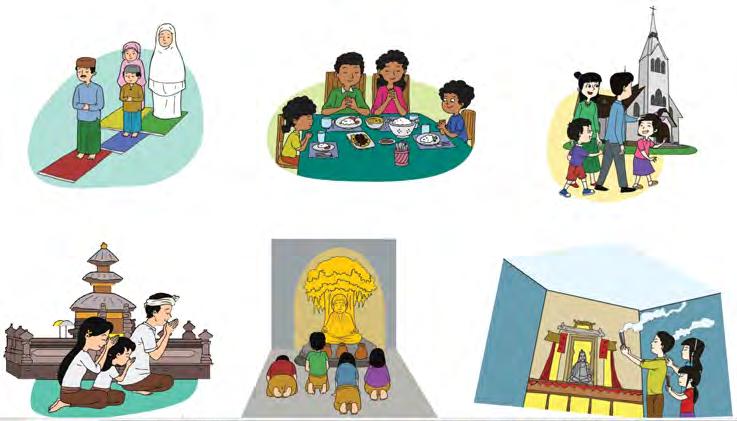
Udin: (second student from left, Figure 1) is a character who wears glasses. It can be seen from Figure 3 (below) that his mother wears a hijab. Figure 4 shows that Udin is praying with his family in Islamic liturgy. It can be interpreted that Udin grows up in a Muslim family and identifies himself as a Muslim student.
Figure 3
Udin’s Family (Textbook Theme 1, p. 2)
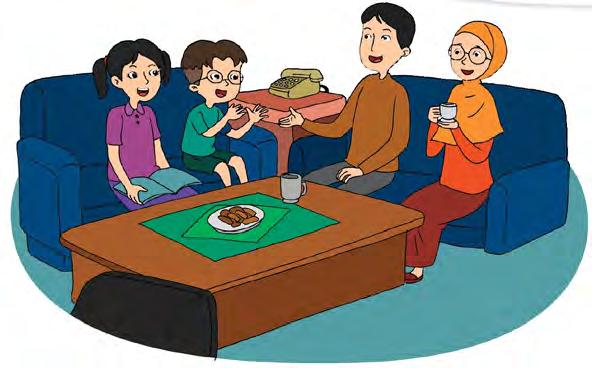
Figure 4
Islamic Prayer (Textbook Theme 8, p. 48)
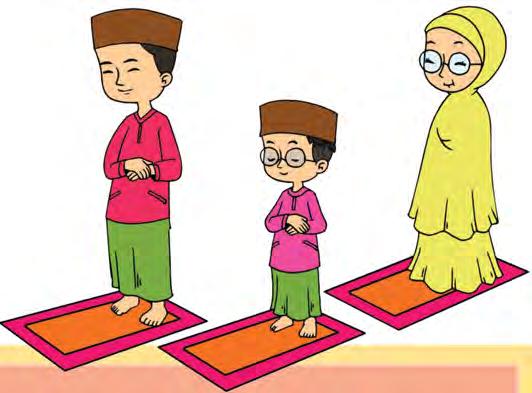
Beni: (third student from left, Figure 1) has light skin and straight hair. From Figure 5 (below) bottom-middle picture, it can be seen that there is a boy who has light skin and straight hair is praying in Buddhism liturgy. From Figure 6 number 6 it can be seen that the boy with light skin and straight hair, is participating in Bible reading. Thus, there is unclear information whether Beni is Buddhist or Christian.
Figure 5
Religious traditions (Textbook Theme 1, p. 14)

Figure 6
Daily activities (Textbook Theme 5, p. 81)
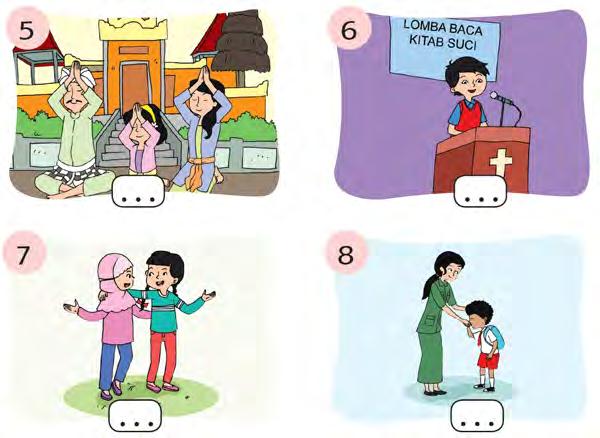
Dayu: has straight hair and wears a headband (middle student, Figure 1). According to how Balinese depict nicknames in general, Dayu is a short name of “Ida Ayu”. In Bali, people may notice from the name whether they are male or female. Additionally, according to the Ministry of Religious Affairs (2017), Bali is one of many provinces in Indonesia with the largest Hindu population (83.4%). In this province, the name represents the caste system. For instance, females who are from the Brahmin caste use the name of Ida Ayu as their initial name. It can be interpreted from the name that Dayu represents a girl student from Bali who identifies herself as a Hindu. It can be seen from figure 7, number 4 that a girl who wears a headband was praying in a Mandir / Pura / Candi (temple).
Figure 7
Daily activities (Textbook theme 5, p. 17)
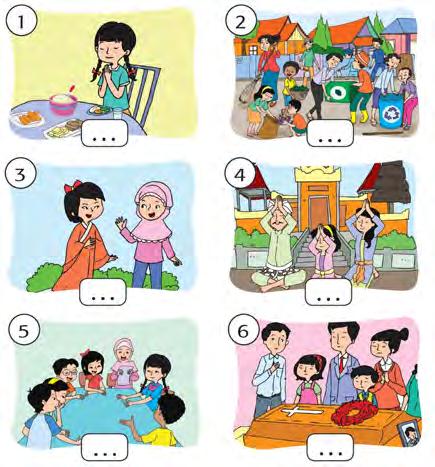
Lani: (third student from right, Figure 1) has the lightest skin among other characters, a round face without a double eyelid, and a pink hair accessory. Lani represents a Chinese descendant. From Figure 8, the top-right picture, it can be seen that she goes to church with her family. She may represent Catholic or Christian.
Figure 8
Religious traditions (Textbook Theme 1, p. 14)

Siti: (second-right student, Figure 1) as it can be seen from the students’ appearance on the Figure 1, Siti represents a Muslim girl who wears a hijab. From the religious artefact worn by Siti and her mother, it can be interpreted that Siti is raised in a Muslim family (Figure 9) and identifies herself as a Muslim.
Figure 9
Siti and her family (Textbook 3, p.3)
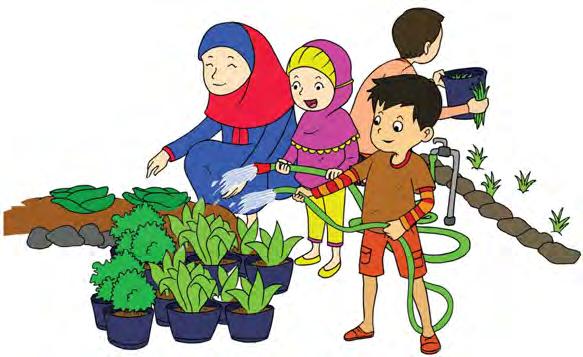
Edo: (the far right student, Figure 1) has darker skin and curly hair. Figure 10 reveals that Edo tells his friend to go to church. It is not clear whether he wants to go to Christian Church or Catholic Church. Thus, it is also unclear whether Edo is Christian or Catholic.
Figure 10
Edo’s Conversation with his Friends (Textbook theme 1, p. 66)
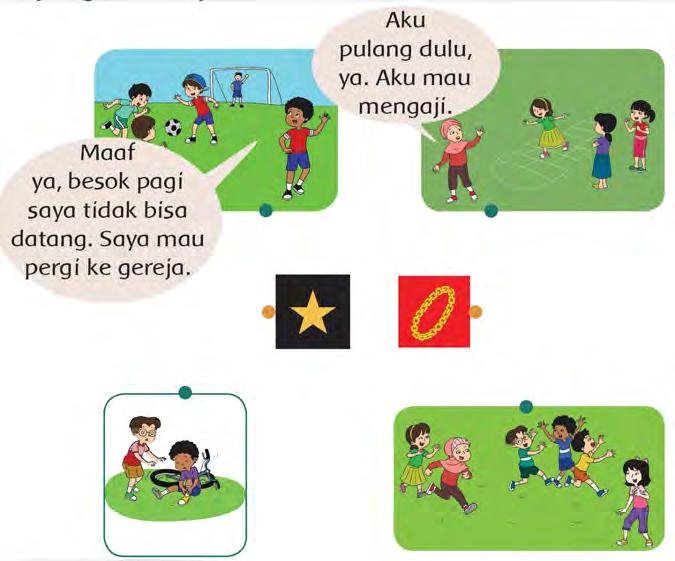
Table 1 (below) summarizes the names and religious main characters presented in each textbook. When they serve as the main characters, it means that their daily narratives dominate the textbooks.
Table 1
Summary of the Names and Religious Main Characters
Name of the main characters
Characters’ religious background
Textbook Theme 1 Textbook Theme 2 Textbook Theme 3 Textbook Theme 4 Textbook Theme 5 Textbook Theme 6 Textbook Theme 7
Textbook Theme 8
Udin Beni Siti Dayu Beni Lani Siti Udin
Muslim Christian/ Buddhist Muslim Hindu Christian/ Buddhist Christian/ Catholic Muslim Muslim
Where am I?
It can be seen from the table that there was an unequal representation of characters among eight textbooks. There were 5 characters (Udin, Beni, Siti, Dayu, and Lani) presented in eight textbooks. Udin was presented in textbook theme 1 and theme 8. Beni was presented in textbook theme 2 and theme 5. Siti was presented in textbook theme 3 and 7. Dayu was presented in textbook theme 4. Lani was presented in textbook theme 6. The characters of Meli (Confucian) and Edo (Christian or Catholic) were missing or not presented as the main characters in any textbooks. As there were only 5 characters (Udin, Beni, Siti, Dayu, and Lani)
represented as main characters in the second-grade textbooks, there is woeful misrepresentation of religious diversity of Indonesia. According to the Ministry of Religious Affairs (2017), there are six religions and other beliefs acknowledged by the Indonesian governments. Udin and Siti are characters that represent Muslim, Dayu is a character that represents Hindu, and Beni is a character that may represent Christian or Buddhist. As such, the representation of Confucian and other beliefs is absent. The seven characters should have represented the religious diversity of Indonesia. However, since there are eight textbooks, the authors have doubled the representation of three characters (Beni, Udin, and Siti) without providing obvious reasons of doubling the representation. For students, examining which characters are presented doubled, allows them to engage in critical analysis of how certain religions have exercised power (Enciso & Davilla. n.d).
Indeed, the characters Muslim, Christian, Catholic, and Buddhism were presented as main characters while the rest (Confucian) was presented as additional subordinate characters. Table 1 shows that Udin, Beni, Siti, Dayu, and Lani are the main characters presented in each textbook. For instance, Lani (Christian or Catholic) was presented as the main character in textbook theme 6. Others were presented as Lani’s friends who accompanied her playing or studying. From theme 6, Lani’s daily activities were presented more frequently than the additional characters. This finding speaks to the issue of unequal power among religious groups. Also, they should engage students in critical discussion about how certain religions gain privilege when presented as the primary characters.
Lastly, the representation of Muslims dominates the eight textbooks. The table demonstrated that there was a repetition of two Muslim characters (Udin and Siti) presented in textbooks as the main characters. The character of Udin was repeated in textbooks theme 1 and theme 8. Similarly, the Muslim character Siti was repeated in themes 3 and 7. As such, the Muslim characters were presented four times in second grade textbooks. This particular finding suggests that people who believe in the dominant religion are accorded more social power and privilege (Van Djik, 1993) in social institutions including education, than those who practice minority religions.
Discussions
The study’s finding suggests that in using textbooks, teachers need to pay more attention to the characters presented. Teachers may engage students in critical examinations of how semiotic modes (such as images) are used to convey control and social position (Kress & Leeuwen, 2010). Furthermore, since the characters are presented across school levels, teachers, educators, authors, publishers and caregiver of students would do well to introduce critical thinking skills, question stereotypical representations of minority groups, and challenge the knowledge in textbooks and other curricular materials (Chu, 2015). Critical thinking guides students to understand how their world is read through words, texts, and images (Freire, 1985). As Enciso and Davilla (n.d.) argue, “Classrooms are social and political spaces where social narratives and histories of knowing, being, and acting are integrated into ellipsis literature selection” (p. 16). Thus, students and teachers can gain understanding about the importance of curricular materials, as school is a place to not only reinforce social justice but also to plant and nurture the seeds of social transformation (Sensoy, 2014).
As a native Indonesian scholar who believes in respecting all people and their belief systems for the purposes of social justice, I have tried to show how minoritized religious groups are missing from educational materials. When people acknowledge the importance of religious
diversity, they honor all people’s lives and presence. Drawing on a bigger scale, I have found that hegemonic groups control the school curriculum in Indonesia. I have also demonstrated that it is crucial for children to feel represented in the literature.
Suggestions
The present study examines the religious representation in Indonesian elementary textbooks by looking at what knowledge about religious representations are constructed and whose perspectives are valued in the process of scaffolding knowledge presented. Through this analysis, I hope Indonesian elementary students learn respect and tolerance in a meaningful way so that they can value the diversity and richness of the narratives in Indonesian culture from both dominant and minority groups. Textbooks, like Buku Siswa, contribute significantly to students’ understanding of current phenomenon. Thus, there is a need to scrutinize and unpack learning materials used in schools globally as a way to challenge dominant narratives (Chu, 2018). Future research should also consider examining the learning materials from all grade levels, especially when there is a continuum topic or characters presented. This includes the analysis of race, gender, and other dimensions of differences.
Acknowledgement
I would like to extend my appreciation to the Indonesia Endowment Fund for Education (LPDP) for supporting my doctoral study at the Ohio State University, U.S.A. I completed this article during my study.
Note
There are multiple authors for the series of Indonesian elementary textbooks, Buku Siswa.
Data Availability Statement
The data that support the findings of this study are openly available in Buku Sekolah Digital.com at https://bsd.pendidikan.id/bsd.html.
References
Ahnaf, M. I., Susanto, T., Miqdad, M., Sulaiman., T. M. J., Azuz, F. M., Tarawiyah, S., Uran, R., Mara, F. A. D., Prawono, S. A., Tantowi, Y., Abid, M. H., Ashadi, A., Wahab, O. H., Hasanah, I., Fatah, A., Ruliandi, E. (2015). Praktik Pengelolaan Keragaman di Indonesia, Kontestasi dan Koeksistensi. Center for Religious and Cross-Cultural Studies. Retrieved from https://crcs.ugm.ac.id/news/3428/buku-baru-praktekpengelolaan-keragaman-di-indonesia-kontestasi-dan-koeksistensi.html Alim, D. (1996). Lancar Berbahasa Indonesia 3. Jakarta: Balai Pustaka. Apple, M.W. (2004). Ideology and curriculum (3rd ed.). New York, NY: Routledge. Astuti, I. M. J. (2017). Hidup Rukun: Buku Tematik Terpadu Kurikulum 2013. Pusat Kurikulum dan Perbukuan, Balitbang, Kemendikbud. Astuti, I. M .J. & Susilawati, F. (2017). Merawat Hewan dan Tumbuhan: Buku Tematik Terpadu Kurikulum 2013. Pusat Kurikulum dan Perbukuan, Balitbang, Kemendikbud. Badan Pusat Statistik. 2015. Mengulik Data Suku di Indonesia. Retrieved from https://www.bps.go.id/news/2015/11/18/127/mengulik-data-suku-di-indonesia.html Banks, J. A. (Ed.). (1996). Multicultural education: Transformative knowledge and action. Teachers College Press. Bartz, J., & Bartz, T. (2018). Recognizing and Acknowledging Worldview Diversity in the Inclusive Classroom. Educ. Sci. 8, 196. https://doi.org/10.3390/educsci8040196 Chu, Y. (2018). Visualizing minority: Images of ethnic minority groups in Chinese elementary social studies textbooks. The Journal of Social Studies Research, 42(2), 135-147. https://doi.org/10.1016/j.jssr.2017.05.005 Enciso, Patricia., & Denise L. Davilla. (n.d). Teaching with transformative literature K-8: Centering social equality in literary reading. Transformative Literature, [Unpublished manuscript]. Fairclough, N. (1992). Discourse and social change (Vol. 10). Cambridge: Polity press. Faisal. (2017a). Hidup Bersih dan Sehat: Buku Tematik Terpadu Kurikulum 2013. Pusat Kurikulum dan Perbukuan, Balitbang, Kemendikbud. Faisal. (2017b). Keselamatan di Rumah dan Perjalanan: Buku Tematik Terpadu Kurikulum 2013. Pusat Kurikulum dan Perbukuan, Balitbang, Kemendikbud. Fitriyani, M. (2013). A textbook analysis of “When English Rings the Bell” A textbook for the seventh grade of junior high A thesis. 81. Yogyakarta State University. Foucault, M., & Gordon, C. (1980). Power/knowledge: Selected interviews and other writings, 1972-1977 (1st American ed). Pantheon Books. Freire, P. (1985). Reading the world and reading the word: An interview with Paulo Freire. Language arts, 62(1), 15–21. https://doi.org/10.1007/978-1-349-17771-4_12 Gee, J. P. (1989). Literacy, discourse and linguistics. Journal of Education, 171(1), 26–38. https://doi.org/10.1177/002205748917100101 Hughes, S. A. & Pennington, J. L. (2017). Autoethnography: Process, product, and possibility for critical social research. SAGE.
Jannah, D. F. N. (2015). Analisis Kesesuaian Isi Buku Siswa Kelas II SD Tema 1: Hidup Rukun Subtema 1: Hidup Rukun di Rumah dengan Kurikulum 2013. SKRIPSI Jurusan Kependidikan Sekolah Dasar & Prasekolah - Fakultas Ilmu Pendidikan UM, 0(0), Article 0. http://karya-ilmiah.um.ac.id/index.php/KSDP/article/view/38982 Jones, G. W. (1976). Religion and education in Indonesia. Indonesia, (22), 19–56. https://doi.org/10.2307/3350976 Kress, G. R., & Leeuwen, T. van. (2010). Reading images: The grammar of visual design (2. ed., reprinted). Routledge. Kusumawardani, P. (2017). Analisis Bentuk Tematik Buku Siswa Kelas II SD Semester Genap. SKRIPSI Jurusan Kependidikan Sekolah Dasar & Prasekolah - Fakultas Ilmu Pendidikan UM, 0(0), Article 0. http://karyailmiah.um.ac.id/index.php/KSDP/article/view/56917 Lazar, M. M. (2007). Feminist critical discourse analysis: Articulating a feminist discourse praxis1. Critical Discourse Studies, 4(2), 141–164. https://doi.org/10.1080/17405900701464816 Mahoni.com. (2019). Buku Sekolah Digital.com: Download 2500 Buku. [Mobile app]. Kurikulum 2013. https://bsd.pendidikan.id/bsd.html Ministry of Religious Affairs Public Relations, Data and Information Bureau. (2017). Kementerian Agama dalam angka 2016. Retrieved from https://kemenag.go.id/myadmin/public/data/files/users/3/KEMENAG%20DALAM%2 0ANGKA%202016---OK%20(1).pdf Mitchell, W. J. T. (1990). Representation.InF. Lentricchia, & T. McLaughlin( Eds.), Critical termsforliterarystudy (pp. 11–22). Chicago, IL: TheUniversity of Chicago Press. Moreno-Fernández, O., Moreno-Crespo, P., Pedrero-García, E., & Hunt-Gómez, C. I. (2019). Spanish first cycle primary school textbooks’ graphic representations. A study on gender, culture and functional diversity. Ispanijos Pirmosios Pakopos Pradinių Mokyklų Vadovėlių Grafiniai Vaizdai. Lyčių, Kultūros Ir Funkcinės Įvairovės Tyrimas., 136(4), 67–88. https://doi.org/10.15823/p.2019.136.5 Nurhidayah., Putra, J., Making, K. B., Listiyantoro, S. I., Ali, F. V. A., Situmorang, A., Halidin, H., Hadiseputra, R. M. A. (2018). Praktik Pengelolaan Keragaman di Indonesia. Jalan - Jalan Alternatif Membangun Inklusi Sosial. Center for Religious and Cross-Cultural Studies. Retrieved from https://crcs.ugm.ac.id/download/bukukedua-praktik-pengelolaan-keragaman-di-indonesia/ Parlindungan, F., Rifai, I., & Satriani, A. (2018). The representation of Indonesian cultural diversity in middle school English textbooks. Indonesian Journal of Applied Linguistics, 8, 289–302. https://doi.org/10.17509/ijal.v8i2.13276 Purnomosidi. (2017a). Kebersamaan: Buku Tematik Terpadu Kurikulum 2013. Pusat Kurikulum dan Perbukuan, Balitbang, Kemendikbud. Purnomosidi. (2017b). Tugasku Sehari – hari: Buku Tematik Terpadu Kurikulum 2013. Pusat Kurikulum dan Perbukuan, Balitbang, Kemendikbud.
Sensoy, O. (2014). Beyond rearing the savage: Responding to Islamophobia in the classroom. In E. W. Ross (Ed.), The social studies curriculum: purposes, problems, and possibilities. Retrieved from http://search.ebscohost.com/login.aspx?direct=true&scope=site&db=nlebk&db=nlabk &AN=884446 Suhadi., Yusuf. M., Tahun, Marthen., Asyhari, Budi., Sudarto. (2015). The politics of Religious Education, the 2013 Curriculum, and the Public Space of the School. Center for Religious and Cross-Cultural Studies. Retrieved from https://crcs.ugm.ac.id/download/the-politics-of-religiouseducation/?wpdmdl=6400&refresh=5ea6415c965301587954012 Taufina. (2017a). Bermain di Lingkunganku: Buku Tematik Terpadu Kurikulum 2013. Pusat Kurikulum dan Perbukuan, Balitbang, Kemendikbud. Taufina. (2017b). Pengalamanku: Buku Tematik Terpadu Kurikulum 2013. Pusat Kurikulum dan Perbukuan, Balitbang, Kemendikbud. Thomas, G. (2015). How to do your case study (Second edition). SAGE Publications Ltd. Van Dijk, T. A. (1993). Principles of Critical Discourse Analysis. Discourse & Society, 4(2), 249–283. https://doi.org/10.1177/0957926593004002006 Wahyuni, F. (2015). Kuriukulum dari Masa ke Masa. 10(2), 7. Yiting Chu (2015). The power of knowledge: a critical analysis of the depiction of ethnic minorities in China’s elementary textbooks, Race Ethnicity and Education, 18:4, 469–487. https://doi.org/10.1080/13613324.2015.1013460 Yosso *, T. J. (2005). Whose culture has capital? A critical race theory discussion of community cultural wealth. Race Ethnicity and Education, 8(1), 69–91. https://doi.org/10.1080/1361332052000341006
Corresponding author: Maretha Dellarosa Email: dellarosa.1@osu.edu





